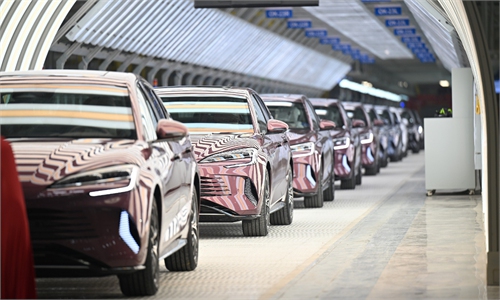
Photo: VCG
Fueled by policy support and market demand, China's artificial intelligence (AI) industry surpassed 700 billion yuan ($96.06 billion) in 2024, having sustained a growth rate of more than 20 percent for several consecutive years, according to a report released by the China Center for Information Industry Development on Saturday.This figure is not just a testament to the thriving vitality of China's AI industry but also a harbinger of new opportunities for global technological advancement and the consumer market.
This achievement didn't come out of nowhere. It was built upon the solid foundation of China's digital infrastructure. The number of generative AI users in China has exceeded 250 million. China has more than 1.1 billion internet users, the penetration rate of mobile payments among its mobile internet users has reached 86 percent, and 5G base stations account for more than 60 percent of the global total. All of these have created a fertile ground for the rapid deployment of AI technologies, supporting the continuous expansion of the AI industry's scale.
Central to this industrial growth is the synergistic interplay among forward-thinking policy frameworks, robust market demand and relentless technological innovation, which has created a full-chain support system for AI - from research and development (R&D) to application.
Since the State Council released the New Generation AI Development Plan in 2017, policy incentives have been rolled out at the central and local levels. These policies have not only provided financial incentives but also accelerated scientific R&D and computing power infrastructure construction, facilitating rapid technology commercialization.
Market demand has been equally instrumental. AI applications in healthcare, finance, education and manufacturing have revolutionized efficiency and the quality of life, spurring companies to increase R&D investment. According to the World Intellectual Property Organization, China has emerged as the leading country in terms of AI-related patent holdings globally, accounting for 60 percent of the world's total. The number of AI large language models worldwide has reached 1,328, with 36 percent from China, the second-largest proportion only after the US, said a white paper released by the China Academy of Information and Communications Technology in July 2024.
What is particularly noteworthy is that China's AI applications are leading the global AI application and consumer market trends. By leveraging its robust manufacturing base, China has effectively integrated AI with various application technologies and products, consistently introducing innovative offerings that are shaping consumer trends and gaining traction in the international market.
Take the smart home sector as an example, Chinese-developed smart speakers, smart door locks and smart home appliances have achieved great success in the domestic market and are gradually gaining popularity globally. Chinese brands occupied eight of the top 10 spots in the global smart robot vacuum cleaner market in the third quarter of 2024, with a combined market share exceeding 60 percent, data from research companies Omdia and International Data Corp showed.
In intelligent vehicles, Chinese automakers and tech firms are collaborating on autonomous driving systems and smart cockpits, which has attracted great attention and interest within the global industry.
In addition, China has made remarkable strides in the development of AI-powered robots. From household cleaning robots to educational robots, Chinese AI-powered robots are increasingly capturing the attention of consumers. As technology advances and costs decline, AI-powered robots are poised to become a new trend of the global consumer market in the coming years.
It is highly likely that the potential of the global consumer market, especially the electronic consumer market, will be unleashed more and more due to China's AI-led developments. As AI continues to permeate global economies, China's role as a driver of inclusive, innovative growth will only become more pronounced.



